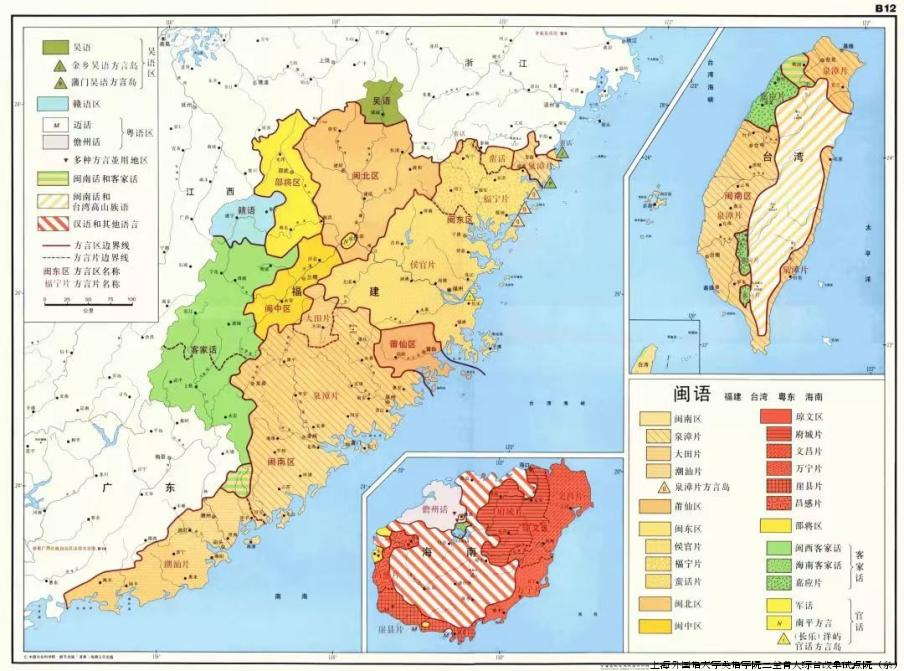编者按
2020年起,为促进中华优秀传统文化的国内传播与国际化译述,上海外国语大学英语学院打造大型实践活动“记忆的味道”,追寻五湖四海的记忆,讲述文化背后的故事。上外英院传统文化志愿服务队于每年寒暑假分赴祖国七大方言区,聚焦非遗及传统文化进行实践与探索。活动围绕家乡年俗、红色文化、手工游艺、音乐舞蹈、二十四节气、非遗文化、非遗美食等中华优秀传统文化进行实践,取得丰硕成果,曾获得“挑战杯”“互联网+”“致远计划”社会实践大赛等国家级、市级、校级奖项。本季“记忆的味道”聚焦传统建筑,将推出双语视频、双语推送讲述建筑艺术中的非遗文化,感悟非遗传承背后的动人故事,推动中华优秀传统文化的国内外传播。

闽方言区
闽方言是我国现代汉语七大方言之一,其音韵形态古老,语言形态上与其他方言差异最大。(The Min dialect is one of the seven major dialects in China. Its ancient linguistic system, especially its phonology, distinguishes itself significantly from other dialects.)闽方言区主要分布于福建省、海南省、台湾地区及广东省局部地区。泉州属于闽方言中的闽南语区。
“半城烟火半城仙”是泉州独特的城市印记。漫步街巷,追随升腾的烟火气,不时能听见三两朋友之间笑谈“厝边头尾”(邻居),相邀“有空去厝内坐坐”。在闽南语中,“厝”指房子,闽南传统建筑“红砖厝”便是用红砖盖的房子。(In the Minnan dialect, the word “cuo” refers to a house, while the traditional Minnan architecture known as “Hongzhuancuo” denotes houses constructed using red bricks.)
本期“记忆的味道”将带领大家走进闽南,到厝内坐坐,聆听砖与石的乐章,体悟游子与家乡的情结。
缘起
“皇宫起”,即按皇宫式样建造的大厝,属于闽南古厝的一种建筑式样,相传源起于唐五代时期,至今已有一千多年的历史。据研究,闽南红砖建筑聚落的最早建造者大多是历史上举族南迁福建的中原人,各族群或家族选好适合自身发展的地理位置,或依山傍水,或顺地形而建,经过数百上千年的建造、扩展而成。(According to research, the earliest red-brick complexes in Minnan were built by people from the central plains who migrated southward to Fujian. Various ethnic groups or families settled in geographical locations that best suited them, either residing in the mountains and along rivers or building their houses along the terrain. Over hundreds of thousands of years, through construction and expansion, these complexes have developed distinctive forms.)
闽南古厝的建筑语言
“红砖白石双坡曲,出砖入石燕尾脊,雕梁画栋皇宫式,石雕木雕双合璧”。泉州古民居专家黄金良简明概括了闽南传统民居的建筑特色。
红色在中国是吉祥、喜庆的象征,也是古代宫殿建筑中最常用的一种色彩。从建筑的屋顶、墙身到地面,闽南古厝大量使用当地烧制的红砖。(Red, symbolizing good luck and festivity in China, is one of the most commonly used colors in ancient palace architecture. From rooftops and walls to the ground, the ancient houses (gucuo) in Minnan showcase an extensive use of locally crafted red bricks.)相比中原建筑含蓄素淡的色调,闽南古厝色彩明丽,更具开放热闹的氛围。
“出砖入石”是闽南建筑独有的砌墙方式。“砖”即闽南红砖, “石”主要是花岗岩块。砖石混砌,形状、大小不一,厚度不等。不同砌筑方式以及砖石相错所构成的多种图案、文字使建筑立面具有色彩明快、内涵丰富、自然和谐的艺术效果。(Different masonry techniques and the interplay of bricks and stones form a multitude of patterns and characters, resulting in vibrant colors and imbuing the building facades of Minnan ancient complexes with rich artistic effects that are meaningful, natural, and harmonious.)
古厝屋脊呈燕尾脊、马鞍脊等造型,构成优美的建筑曲线。燕尾脊高高扬起,利于排水、避雷、消减风力,为方方正正的古厝平添了几分灵动。(The upward curve of Swallowtail Ridges serves practical purposes such as efficient drainage, lightning protection, and reduction of wind force. Additionally, it imparts a touch of liveliness to the square and well-proportioned ancient houses.)
闽南古厝以三开间为基本单位,由数个单体建筑及外部空间组合衍化而成,承袭了中华传统建筑讲究对称、严谨的特质,同时融合了各种雕饰,充分体现了闽南古建筑巧、美、秀、雅的风格。(Minnan ancient houses are based on a three-bay room unit, formed by the combination of multiple individual buildings and external spaces. They inherit the traditional Chinese architectural principles of symmetry and meticulousness while incorporating various ornate carvings. This fusion fully embodies the exquisite, beautiful, graceful, and refined style of Minnan ancient architecture. )
闽南古厝的精神内核
闽南古厝不仅满足了人们居住的各项需求,也给予了当地人民无尽的精神力量。(Minnan ancient houses not only fulfill various residential needs but also provide the local people with boundless spiritual strength.)红砖厝是儿时的欢笑,写在长大离家后的梦里,诉说着闽南人对家的情思。“双燕归脊”的形制便巧妙地将“燕子回巢”之意、父母盼儿归之情挥洒于苍穹。
闽南古厝建筑群多以家族为中心建立,实现了居住、家族教育、宗庙祠堂三位一体的生活布局 (Minnan ancient house complexes are predominantly established around families, embodying a holistic living layout that encompasses residence, family education, and ancestral halls),见证了家族代代在万载时空中的赓续。清末民初,不少“下南洋”打拼的闽南人功成名就后不忘家乡,情系桑梓,不惜花重金回乡“起厝”(建房子)的故事便是生动的实例。
闽南传统民居营造技艺于2008年入选国家非物质文化遗产代表性项目名录。(The traditional residential construction craft in Minnan was included in the Representative List of the State-level Intangible Cultural Heritage in 2008.) 一砖一瓦,酝酿了闽南古厝丰富多彩的建筑表达。燕脊高翘,飞扬着闽南人对生活的思考与祈愿。迈进新时代,红砖厝仍旧传承着珍贵的城市记忆,努力奏响古厝新声。
参考文献
[1] 中国语言地图集第2版汉语方言卷.[M].北京:商务印书局, 2012.
[2] 唐宏杰.闽南“皇宫起”建筑起源及相关问题探略[J].福建文博,2016(01):69-72.
[3] 潘志坚.试论闽南传统红砖建筑营造技艺在当前社会环境的保护实践与应用[J].文物鉴定与鉴赏,2022(20):142-146.
[4] 黄金良.泉州民居[M].海风出版社,1990.
[5] 宁小卓.多元文化催生下的民居奇葩——闽南蔡氏古民居的成因探析与特征研究[J].中外建筑,2007(09):58-63.
[6] 汪晓东.“出砖入石”渊源考辨[J].装饰,2018(09):106-109.
[7] 周红.蔡氏红砖厝民居建筑艺术风格与装饰[J].装饰,2007(03):85-87
[8] 唐宏杰.瓦当与闽南红砖建筑文化[J].东方收藏,2015(03):111-114.
[9] 厝 - 《中国大百科全书》第三版网络版
https://www.zgbk.com/ecph/words?SiteID=1&ID=533368&Type=bkztb&SubID=826
[10] 闽南传统民居营造技艺 - 中国非物质文化遗产网·中国非物质文化遗产数字博物馆
https://www.ihchina.cn/art/detail/id/14683.html
[11]【闽山闽水物华新】泉州 | 随人民日报走进梧林,感受古厝四时新 https://mp.weixin.qq.com/s/O6R2tcXFcVhoUQxlmYoJUA
[12] 泉州古建筑,好看又好听!
https://mp.weixin.qq.com/s/zxNBp6xMZCUNHmVUXs5QuA
[13]闽南古厝_百度百科
https://baike.baidu.com/item/%E9%97%BD%E5%8D%97%E5%8F%A4%E5%8E%9D/13344655?fr=ge_ala
译文参考文献
[1]Traditional architecture highlights Fuzhou's newest tourist site - Chinadaily.com.cn
https://www.chinadaily.com.cn/a/202007/08/WS5f05cae7a310834817258267.html
[2] The hidden treasures of Fujian – Chinadaily.com.cn
https://www.chinadaily.com.cn/cndy/2014-10/06/content_18699198.htm
部分资料、图片来源于网络
文案 | 孙琦 黄昱彬
翻译 | 陈秋蒙 陈阵阳
翻译指导 | 龙超
排版 | 谢双
审校 | 陈若洁 刘芸 牟家慧
审核 | 李秀秀
策划 | 上外英院传统文化志愿服务队
我要评论 (网友评论仅供其表达个人看法,并不表明本站同意其观点或证实其描述)
全部评论 ( 条)